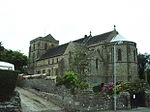Wraysholme Halt railway station
Former Furness Railway stationsPages with no open date in Infobox stationPrivate railway stationsRailway stations in Great Britain closed in 1922Railway stations in Great Britain opened in 1911
Wraysholme Halt was a railway station on the Furness Railway in the Furness exclave of Lancashire. Situated between Cark and Cartmel and Kents Bank the halt was not open to the public and was used by the British army's Territorial Force as a railhead for troops training at the Rougholme Rifle Range at nearby Humphrey Head.
Excerpt from the Wikipedia article Wraysholme Halt railway station (License: CC BY-SA 3.0, Authors).Wraysholme Halt railway station
Wraysholme Lane,
Geographical coordinates (GPS) Address Nearby Places Show on map
Geographical coordinates (GPS)
| Latitude | Longitude |
|---|---|
| N 54.170277777778 ° | E -2.9486111111111 ° |
Address
Wraysholme Lane
Wraysholme Lane
LA11 7LZ , Lower Allithwaite
England, United Kingdom
Open on Google Maps









